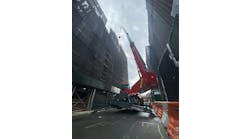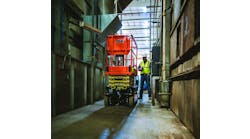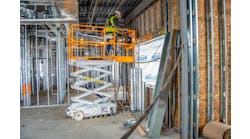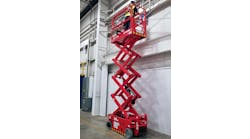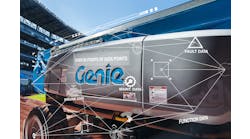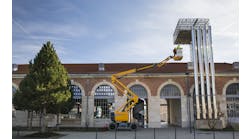Tim Ford, President, Terex AWP, talks about the effects of Tier-4 regulations, the need for more advanced electronic controls, technological changes on scissors and telehandlers, and the critical importance of safety training.
By Michael Roth, RER
RER: Tell us about new technological developments on your equipment?
Ford: We have been working hard to prepare for EPA emissions regulations known collectively as Tier 4 in North America. This will require the re-powering of all of our products with engines larger than 25 hp. Previous Tier changes have had little effect on the product, but the Tier-4 changes will require exhaust after-treatment and increased heat rejection. The packaging of the after-treatment and larger radiators will result in some product changes. We also have significant internal and field testing planned to ensure a quality product for our customers.
What are some of the trends you expect to see in the coming years in aerial equipment?
The Tier-4 engines will have electronic controls in most cases. This will require more advanced electronic controls for machine functions. In addition, there are international standards developing that will require control system changes that can only be solved with embedded microprocessor controls. Terex AWP is working on developing the control systems of the future that meet these requirements and have the robustness for surviving the construction and rental industry environments.
In scissors, specifically, the need has grown for lighter weight machines. The key, however, is to produce machines that are durable and will withstand jobsite wear and tear, which is why we put such emphasis on building quality products. Our customers still expect the equipment to be of high quality and durability.
In telehandlers, cab comfort has grown in importance as it can provide enhanced jobsite productivity. There is a growing move to larger telehandlers especially in the 12-15k range. In addition, interest in hybrid technology as a means of lowering emission and improving fuel economy is gaining ground in the compact market and will eventually migrate to bigger machines.
In terms of the rental market, we hope we may be seeing something of a recovery in the second half of this year and going into 2011. What are your expectations for the economy?
We have seen some areas of growth in the first half of 2010, but we still have a long way to go to full recovery. We expect limited growth for the rest of 2010, with most customers still using caution into 2011. We will continue to develop new products that will enable us to give our customers innovation and quality as the market recovers.
What types of equipment do you recommend for rental fleets as we go into, hopefully, a recovery? And why?
As the demand for rental equipment increases, most end users and contractors will want new equipment that is reliable and allows them to get their jobs done accurately and in a timely fashion. It is best to refresh all portions of the rental fleet, such as scissors, telehandlers, booms, AWPs, light towers, etc. Focusing on one or two categories of product will make success a gamble. It is the nature of the rental business that you cannot predict what machine the rental customer will want. It is an on-demand customer-to-rental-business relationship. You need all products to be ready.
What are some of the improvements and new developments your customers have been asking for in your equipment?
Our customers always have wanted the best-quality products and service available. We will continue to do so and focus on continuous improvement. Overall our customers expect equipment to be reliable and provide a good ROI. We strive everyday to accomplish this for them.
What are some of the most important regulatory developments — in terms of aerial safety — currently and how do they play into where you are going in your technology?
Developing markets, such as China and Korea, are beginning to introduce standards. These standards are usually adopted from existing European standards. This is a good thing for the industry. It brings the product safety that is expected in the developed markets.
SIA in conjunction with ARA, AEM and other industry organizations recently introduced a Statement of Best Practices of General Training and Familiarization for Aerial Work Platform Equipment. This provides a framework that will lead to more informed machine operators and jobsite safety.
What areas of aerial safety are you most concerned with right now and what is your company doing in the safety area?
Some of the areas related to aerial safety we would like to see improvement from the industry on are:
-
Operators receiving proper safety training is always of great importance to the industry as a whole. It’s critical that the operator’s employer ensures that the employee receives all of the necessary safety training as it relates to the proper safe operation of the aerial lift equipment. Employers may already have an internal safety training program, but for those that don’t, Terex AWP has a training program to help a qualified trainer train operators. By simply calling Genie at the toll free number 1-800-536-1800, they can place an order for the safety training kit number 72837, which can be used to supplement any additional safety training information the trainer would use during their training class.
-
Notifying the equipment manufacturer of a change of ownership. This is critical to help ensure that the new owner of the equipment will receive any safety-related information from the manufacturer.
-
Another potential area for concern is the service and maintenance of an aerial lift. If an aerial lift is not properly maintained it could result in the machine malfunctioning. A malfunctioning machine should never be operated. It’s important to remember that performing a pre-operation and function test prior to use will identify any potential issues. If anything is out of the ordinary, the machine should be removed from service immediately and repaired by a qualified technician before being placed back into service.
What types of improvements would you most like to see when it comes to aerial work platform safety practices in the rental industry?
Training is critical to safe operation of aerial work platforms. We support industry efforts to make training available. Training needs to be stressed at every level to ensure that only qualified operators are operating the equipment.

